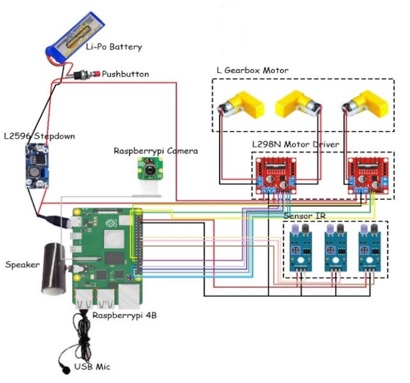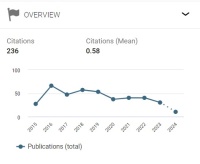Perancangan Robot Mainan Pintar Berbasis Sensor dan Teknologi Machine Learning
Abstract
This research aims to explore the potential of a smart toy robot in supporting the development of early childhood in the continuously evolving digital era. Evaluation is conducted through a series of tests including image classification testing, omnidirectional movement testing, as well as training and testing of sound classification models. Image classification testing is performed to assess the face detection ability at varying distances, where accuracy presentation is quantitatively measured. The test results indicate that the robot is capable of detecting faces with an average accuracy rate of 82.6% at a distance of 10 cm and 79.4% at a distance of 50 cm. Omnidirectional movement testing shows an average error rate of 1.2% with the highest variation in the direction of 90° at -5.33%. Meanwhile, training and testing of sound classification models yield a validation accuracy of 83.4% in identifying specific sounds. Technically, this robot effectively detects faces at different distances, performs omnidirectional movements with high precision, and identifies various sounds with good accuracy. The outcome of this research is the development of a smart toy robot that can serve as an educational tool and stimulation for the development of early childhood. The novelty of this research lies in the comprehensive integration of technology in solutions for children's development in the digital era. Thus, this study provides a significant contribution to understanding and utilizing technology for children's education more effectively and efficiently in this ever-changing era.
Keywords– robot; smart toy; machine learning; toddler motoric skills.
Downloads
References
[2] M. Y. Chang, C. H. Yuan, dan Y. P. Chi, "The Role of Mobile Digital Devices in Early Childhood Development: A Review of Recent Studies," Early Child Development and Care, vol. 193, no. 6, pp. 911-925, 2023. [Online]. Available: https://doi.org/10.1080/03004430.2021.1989633
[3] Jahirin dan Amelinda, "HUBUNGAN PENGGUNAAN GADGET (HANDPHONE) DENGAN POLA PERKEMBANGAN SOSIAL ANAK USIA PRASEKOLAH," VII, no. 2, 2019.
[4] K. Kabali, M. M. Irigoyen, R. Nunez-Davis, J. G. Budacki, S. H. Mohanty, K. P. Leister, dan R. L. Bonner, "Exposure and Use of Mobile Media Devices by Young Children," Pediatrics, vol. 136, no. 6, pp. 1044-1050, 2015. [Online]. Available: https://doi.org/10.1542/peds.2015-2151
[5] R. A. Fidalgo, C. Rocha, dan P. Alves-Oliveira, "Smart Toy in Early Childhood and Primary Education: A Systematic Review of Technological and Educational Affordances," Applied Sciences, vol. 11, no. 15, p. 6734, 2021. [Online]. Available: https://doi.org/10.3390/app11156734
[6] Bian, W. Li, H. Jin, J. Li, Y. Li, dan S. Wang, "A Voice Recognition Sensor and Voice Control System in an Intelligent Toy Robot System," Frontiers in Robotics and AI, vol. 8, p. 712517, 2021. [Online]. Available: https://doi.org/10.3389/frobt.2021.712517
[7] C. L. Casas, V. Charisi, K. Groth, dan F. Wijnen, "Influence of a Socially Assistive Robot on Physical Activity, Social Play Behavior, and Toy-Use Behaviors of Children in a Free Play Environment," Frontiers in Robotics and AI, vol. 8, p. 676553, 2021. [Online]. Available: https://doi.org/10.3389/frobt.2021.676553
[8] B. Setiawan, O. J. Aldo Wijaya, L. H. Pratomo, dan S. Riyadi, "Sistem Navigasi Automated Guided Vehicle Berbasis Computer Vision dan Implementasi pada Raspberry Pi," Jurnal Rekayasa Elektrika, vol. 17, no. 1, pp. 7–14, 2021. [Online]. Available: https://doi.org/10.17529/jre.v17i1.18087
[9] Oktaviani dan I. E. Setiyono, "PESBOOK: Permainan Edukatif Smart Book sebagai Media Stimulasi Motorik Halus Usia Dini," Aulad: Journal on Early Childhood, vol. 5, no. 3, pp. 335–342, 2022. [Online]. Available: https://doi.org/10.31004/aulad.v5i3.387
[10] Mubin, C. J. Stevens, S. Shahid, A. Al Mahmud, dan J. J. Dong, "A Review of the Applicability of Robots in Education," Journal of Technology in Education and Learning, vol. 1, no. 1, pp. 1-18, 2019.
[11] C. Kamga, A. Ghembom, A. Lameck, dan N. Baloian, "A Survey on the Use of Educational Robots for Promoting STEM Education," Journal of Computers in Education, vol. 7, no. 3, pp. 431-451, 2020. [Online]. Available: https://doi.org/10.1007/s40692-020-00166-7
[12] Géron, "Hands-On Machine Learning with Scikit-Learn, Keras, and TensorFlow: Concepts, Tools, and Techniques to Build Intelligent Systems," O'Reilly Media, 2017.
[13] S. Raschka and V. Mirjalili, "Python Machine Learning: Machine Learning and Deep Learning with Python, scikit-learn, and TensorFlow 2," Packt Publishing, 2019.
[14] Goodfellow, Y. Bengio, A. Courville, dan Y. Bengio, "Deep Learning," MIT Press, 2016.
[15] R. S. Sutton dan A. G. Barto, "Reinforcement Learning: An Introduction," MIT Press, 2018.
[16] V. S. Kumar, L. Pullagura, N. V. Kumari, S. Pooja Nayak, B. P. Devi, A. Alharbi, dan S. A. Asakipaam, "Internet of Things-Based Patient Cradle System with an Android App for Baby Monitoring with Machine Learning," Wireless Communications and Mobile Computing, 2022. [Online]. Available: https://doi.org/10.1155/2022/1140789
[17] C. C. Lakshmi, A. B. Deeksha, dan S. Deeksha, "Predicting the Reason for the Baby Cry Using Machine Learning," 2019. [Online]. Available: https://doi.org/10.5281/zenodo.2656353
[18] Y. C. Liang, I. Wijaya, M. T. Yang, J. R. Cuevas Juarez, dan H. T. Chang, "Deep Learning for Infant Cry Recognition," International Journal of Environmental Research and Public Health, vol. 19, no. 10, 2022. [Online]. Available: https://doi.org/10.3390/ijerph19106311
[19] M. K. H. Leung, C. H. Yeung, W. W. W. Fu, W. K. Wong, W. M. Cheung, S. Y. S. Leung, dan S. H. Ling, "Omnidirectional wheel and propulsion system for robotic applications," Robotics and Computer-Integrated Manufacturing, vol. 63, p. 101902, 2020. [Online]. Available: https://doi.org/10.1016/j.rcim.2019.101902
[20] K. L. Seow, S. Y. K. Keng, L. C. Chang, dan C. H. H. Ooi, "Omnidirectional mobility platform for indoor autonomous service robots," Robotics and Autonomous Systems, vol. 142, p. 103755, 2021. [Online]. Available: https://doi.org/10.1016/j.robot.2021.103755
[21] D. Z. Zhang, C. L. Y. Liu, Y. Y. L. Tsang, C. Y. W. Leung, dan C. H. W. Chan, "Design and control of an omnidirectional mobile robot platform with improved maneuverability and stability," Robotics and Autonomous Systems, vol. 147, p. 103881, 2022. [Online]. Available: https://doi.org/10.1016/j.robot.2021.103881
[22] J. Redmon dan S. Divvala, "You Only Look Once: Unified, Real-Time Object Detection," Proceedings of the IEEE Conference on Computer Vision and Pattern Recognition, vol. 1, pp. 779-788, 2018. [Online]. Available: https://doi.org/10.1109/CVPR.2016.91
[23] M. S. N. G. Ni Ketut Novia Nilasari, "Prediksi Nilai Cryptocurrency Dengan," Majalah Ilmiah Teknologi Elektro, Vol.22, No.2, p. 226, 2023. [Online]. Available: https://doi.org/10.24843/MITE.2023.v22i02.P09
[24] K. K. P. I. F. I. D. A. I. W. I.M.P. Arya Winata, "Model Object Detection Neural Network Berbasis Hand," Majalah Ilmiah Teknologi Elektro, Vol.22, No.2, vol. 2, p. 190, 2023. [Online]. Available: https://doi.org/10.24843/MITE.2023.v22i02.P05


This work is licensed under a Creative Commons Attribution-NonCommercial-NoDerivatives 4.0 International License.

This work is licensed under a Creative Commons Attribution 4.0 International License




